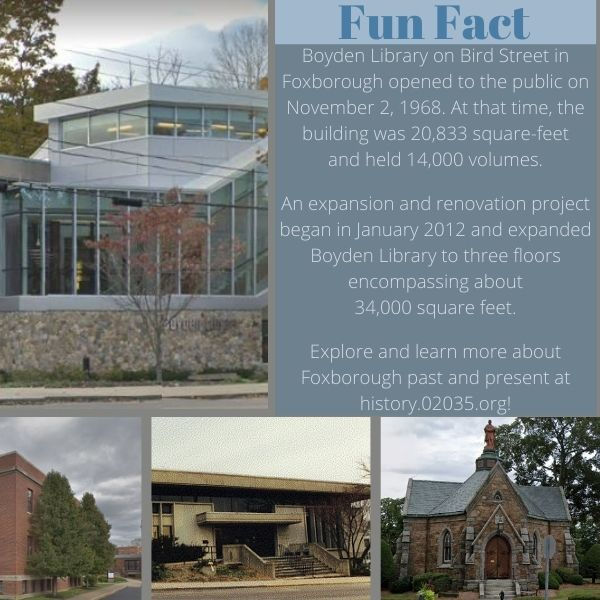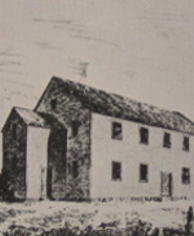
Foxborough Buildings & Structures
Foxborough's historic buildings date back to the 18th century. Come explore the history of some of these great places!
Historic Buildings & Old Homes
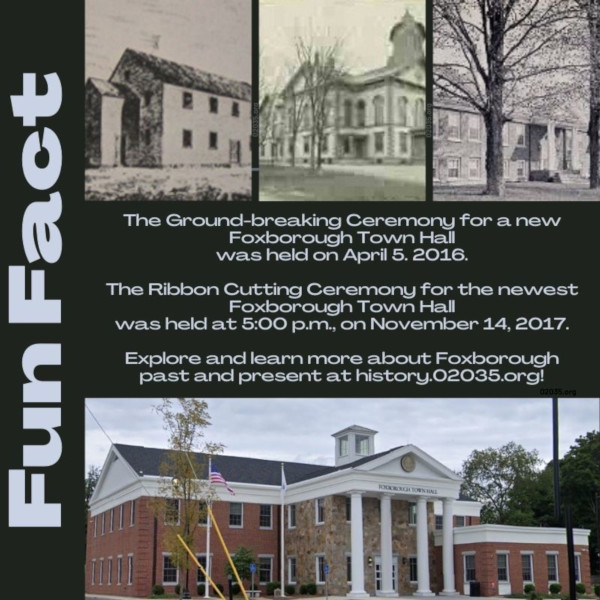
The was built in 1889 and was the first hospital in America for alcoholics.

From Historic Plaque Program
Ezra Carpenter, Jr. was the son of Ezra Carpenter who answered the call of the militia in 1775 and was among the troops who crossed the Delaware with George Washington that Christmas Eve. His son purchased the lot in 1824 just prior to his marriage to Eliza Belcher and built a Cape that would eventually see the birth of 7 children, 3 of which died in infancy. His occupation was Yeoman, "one who farms his own land". He also became a Selectman among other town positions. His son David Carpenter became Superintendent of Rock Hill Cemetery. The property was later owned by the Witschi family who ran the Witschi Dairy.
Linus Carpenter’s house was built on Central Street but when town officials wanted to build the Carpenter School at the current site of the Senior Center, Linus had his house turned around and moved to what eventually became Shaw Place.
Alvan Fales acquired this property from his brother Alfred who owned many acres in the Main Street section of town and may have built the Cape style house for his brother. The blacksmith shop stood for many years eventually converted to a garage before being torn down.
The Paine and Hodges families have ties to this basic Greek Revival style house built by Elias B. Paine, a merchant from Boston and most likely related to the Foxborough Paine family. So numerous were the Paines that the area later called Foxvale was then called "Paineburg". Spencer P. Hodges, a local young man employed by Paine in Boston, bought the property from him in 1854, which then consisted of 3 ˝ acres and "buildings".
This was the first plaque in our Program displayed with a woman’s name. Susan, a "singlewoman", was the daughter of Phillips Payson and granddaughter of Swift Payson, Foxborough’s first Town Clerk. She purchased the land to build her house from her brother-in-law, Daniels Carpenter who was the father of E.P. Carpenter a leader in the building of the Straw-hat industry in town.
Edmund A. Forrest originally built this house around the corner on Granite Street. In 1926, a Bristol family member of The Foxboro Company fame bought the property and had the house moved to its present location on the corner of Union and Granite Streets.
John H. Pond was a commercial florist who, with a partner, established the green houses on Garfield Street under the name of Pond and Plimpton. Mr. Pond afterward built and operated a green house on Clark Street where he developed a variety of carnations called Lillian Pond carnations (named after his wife).
George Josselyn, a carpenter, had just completed his home when, as a firefighter, he responded to the fire at the Union Straw Works, the biggest hat factory in the world. In June 1900, just several days later, the tragic Town House fire erupted and again he responded. He and others were seriously injured when the bell tower collapsed. He was carried to his new home where he died, leaving a wife and two children. "Substantial sympathy" to the widow and children was offered by the fire department who gave their time to grade and seed the lawn and lay out walkways.
The above are some houses in town included in the local "Historic House Plaque Program" which requires a fee for conforming signage. They say there is no fee for research, but there does not appear to be any place/form to submit research inquiries without requesting/paying for a House Plaque.
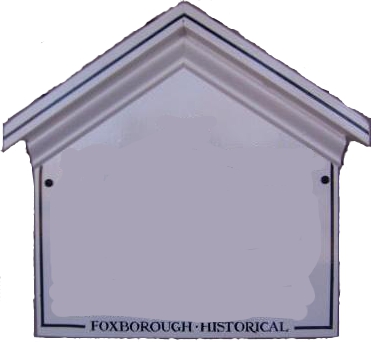
You CAN Do your own research!
Historic Structures
On The National Register
There are at least seven places in Town listed on the National Register of Historic Places, including:
- Seth Boyden House - 135 Oak St. - Also known as Oakwud
- Otis Cary House, 242 South St.
- Foxborough Grange Hall, 11-15 Bird St.
- Memorial Hall, 22 South St.
- Amos Morse House, 77 North St.
- Capt. Josiah Pratt House, 141 East St.
- Ezra Carpenter House, 168 South St. - Also known as Witchie House
- Foxborough Pumping Station, 25 Pumping Station Rd. - Also known as Foxborough Pumping Station #1 Waterworks District
- Foxborough State Hospital, Jct. of Chestnut and Main Sts. Also known as Massachusetts Hospital for Dipsomaniacs & Inebriates. The campus was redeveloped and there was a large fire in some of the buildings on July 14, 2006. It is now referred to as "Chestnut Green".
| Boyden, Seth, House
(added 1983 - Building - #83004092)* Also known as Oakwud 135 Oak Street |
Historic Significance: Architecture/Engineering
Architectural Style: Federal Area of Significance: Architecture Period of Significance: 1700-1749, 1750-1799, 1800-1824, 1825-1849 Owner: Private Historic Function: Domestic Historic Sub-function: Single Dwelling Current Function: Domestic Current Sub-function: Single Dwelling |
|
| Carpenter, Ezra, House
(added 1985 - Building - #85000029)* Also known as Witchie House 168 South Street (10 acres, 1 building) |
Historic Significance: Architecture/Engineering, Event
Architectural Style: Federal Area of Significance: Architecture, Industry, Commerce Period of Significance: 1800-1824 Owner: Local Gov't Historic Function: Domestic Historic Sub-function: Single Dwelling Current Function: Vacant/Not In Use |
|
| Foxborough Pumping Station
(added 2005 - - #05001362)* 25 Pumping Station Road Also known as Foxborough Pumping Station #1 Waterworks District |
Historic Significance: Event, Architecture/Engineering
Architect, builder, or engineer: Boyden, Ernest N., O'Connell, William Architectural Style: Queen Anne Area of Significance: Architecture, Community Planning And Development, Engineering Period of Significance: 1950-1974, 1925-1949, 1900-1924, 1875-1899 Owner: Local Historic Function: Industry/Processing/Extraction Historic Sub-function: Water Works Current Function: Industry/Processing/Extraction Current Sub-function: Water Works |
|
| Foxborough State Hospital
(added 1994 - Norfolk County - #94000695)* Also known as Massachusetts Hospital for Dipsomaniacs & Inebriates (1889-1 Junction of Chestnut Street and Main Street (1760 acres, 38 buildings, 2 structures) |
Historic Significance: Event, Architecture/Engineering
Architect, builder, or engineer: Brigham & Soffard, McLaughlin & Burr Architectural Style: Queen Anne, Colonial Revival, Classical Revival Area of Significance: Social History, Health/Medicine, Architecture Period of Significance: 1875-1899, 1900-1924, 1925-1949 Owner: Private , Local Gov't , State Historic Function: Health Care, Industry/Processing/Extraction, Landscape, Recreation And Culture Historic Sub-function: Auditorium, Energy Facility, Forest, Hospital, Plaza, Sport Facility Current Function: Health Care, Vacant/Not In Use Current Sub-function: Hospital |
|
| Cary, Otis, House
(added 1986 - Building - #86000379)* 242 South St. |
Historic Significance: Person, Architecture/Engineering
Architect, builder, or engineer: Unknown Architectural Style: Greek Revival Historic Person: Cary,Otis Significant Year: 1837 Area of Significance: Architecture, Politics/Government, Industry Period of Significance: 1825-1849, 1850-1874, 1875-1899 Owner: Private Historic Function: Domestic Historic Sub-function: Secondary Structure, Single Dwelling Current Function: Domestic Current Sub-function: Secondary Structure, Single Dwelling |
|
| Foxboro Grange Hall
(added 1983 - Building - #83000595)* 11-15 Bird Street 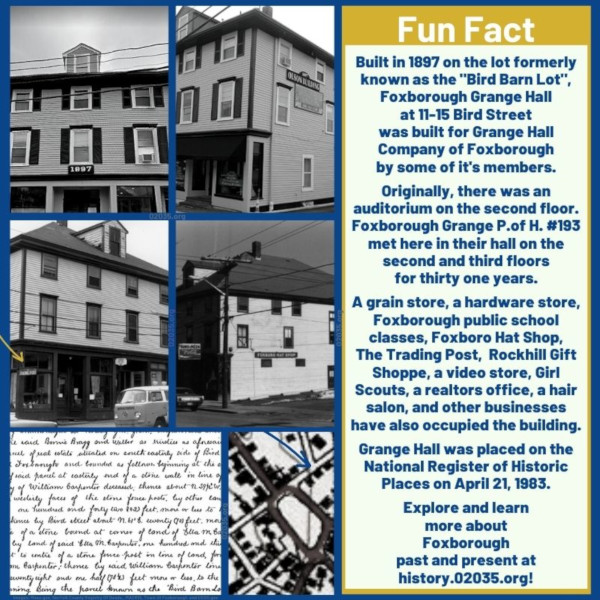 |
Historic Significance: Architecture/Engineering, Event
Architectural Style: Late Victorian Area of Significance: Social History, Architecture, Industry Period of Significance: 1875-1899 Owner: Private Historic Function: Commerce/Trade, Industry/Processing/Extraction, Social Historic Sub-function: Manufacturing Facility, Meeting Hall Current Function: Commerce/Trade, Domestic |
|
| Memorial Hall
(added 1983 - Building - #83000597)* 22 South Street |
Historic Significance: Architecture/Engineering
Architect, builder, or engineer: Stevens,J., Multiple Architectural Style: Gothic Area of Significance: Architecture Period of Significance: 1850-1874 Owner: Local Gov't Historic Function: Education, Recreation And Culture Historic Sub-function: Library, Museum Current Function: Recreation And Culture Current Sub-function: Museum |
|
| Morse, Amos, House
(added 1986 - Building - #86000027)* 77 North Street |
Historic Significance: Event, Architecture/Engineering
Architect, builder, or engineer: Unknown Architectural Style: Federal, Other Area of Significance: Architecture, Industry Period of Significance: 1800-1824, 1825-1849 Owner: Private Historic Function: Domestic, Industry/Processing/Extraction Historic Sub-function: Manufacturing Facility, Multiple Dwelling Current Function: Domestic Current Sub-function: Single Dwelling |
|
| Pratt, Capt. Josiah, House
(added 1983 - Building - #83000598)* 141 East Street |
Historic Significance: Architecture/Engineering, Event
Architectural Style: No Style Listed Area of Significance: Military, Politics/Government, Architecture Period of Significance: 1750-1799 Owner: Private Historic Function: Domestic Historic Sub-function: Single Dwelling Current Function: Domestic Current Sub-function: Single Dwelling |
|
| Foxborough State Hospital ***
(added 1994 - District - #94000695)* Also known as Massachusetts Hospital for Dipsomaniacs & Inebriates (1889-1 Junction of Chestnut Street and Main Street 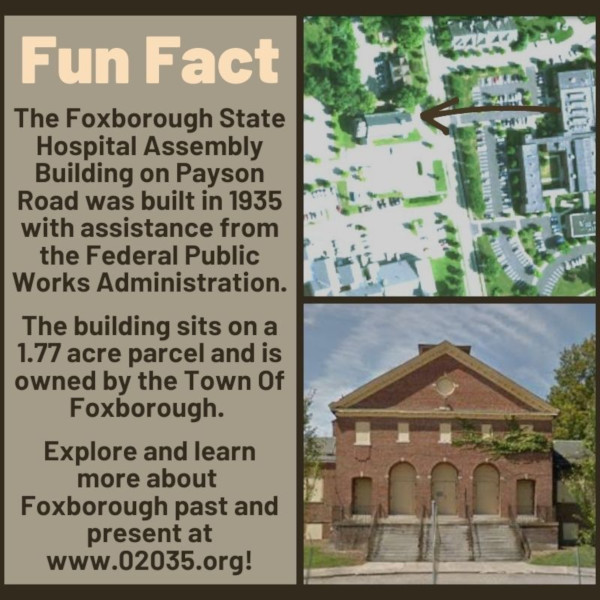 |
Historic Significance: Event, Architecture/Engineering
Architect, builder, or engineer: Brigham & Soffard, McLaughlin & Burr Architectural Style: Queen Anne, Colonial Revival, Classical Revival Area of Significance: Social History, Health/Medicine, Architecture Period of Significance: 1875-1899, 1900-1924, 1925-1949 Owner: Private , Local Gov't , State Historic Function: Health Care, Industry/Processing/Extraction, Landscape, Recreation And Culture
|
Foxborough's History And Historical Sites
- History / Home
- Cemeteries In Town
- Genealogy Information
- Historic Buildings
- Maps
- Military Service & Records
- People & Families
